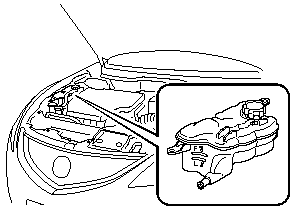Mazda Mazda6: Engine Coolant
 Mazda Mazda6: Engine Coolant
Mazda Mazda6: Engine Coolant
Inspecting Coolant Level
WARNING:
Do not use a match or live flame in the engine compartment. DO NOT ADD COOLANT WHEN THE ENGINE IS HOT:
A hot engine is dangerous. If the engine has been running, parts of the engine compartment can become very hot. You could be burned.
Carefully inspect the engine coolant in the coolant reservoir, but do not open it.

Switch the ignition to off and make sure the fan is not running before attempting to work near the cooling fan:
Working near the cooling fan when it is running is dangerous. The fan could continue running indefinitely even if the engine has stopped and the engine compartment temperature is high. You could be hit by the fan and seriously injured.

Do not remove the cooling system cap when the engine and radiator are hot:
When the engine and radiator are hot, scalding coolant and steam may shoot out under pressure and cause serious injury.
NOTE:
Changing the coolant should be done by an Authorized Mazda Dealer.
Inspect the antifreeze protection and coolant level in the coolant reservoir at least once a year―at the beginning of the winter season―and before traveling where temperatures may drop below freezing.
Inspect the condition and connections of all cooling system and heater hoses.
Replace any that are swollen or deteriorated.

The coolant should be at full in the radiator and between the FULL or F and LOWor L marks on the coolant reservoir when the engine is cool.
If it's at or near LOWor L, add enough coolant to the coolant reservoir to provide freezing and corrosion protection and to bring the level to FULL or F.
CAUTION:
 Radiator coolant will damage paint.
Radiator coolant will damage paint.
Rinse it off quickly if spilled.
 Use only soft (demineralized) water
in the coolant mixture.
Use only soft (demineralized) water
in the coolant mixture.
Water that contains minerals will cut down on the coolant's effectiveness.
 Don't add only water. Always add
a proper coolant mixture.
Don't add only water. Always add
a proper coolant mixture.
 The engine has aluminum parts and
must be protected by an ethylene-glycol-based coolant to prevent corrosion and freezing.
The engine has aluminum parts and
must be protected by an ethylene-glycol-based coolant to prevent corrosion and freezing.
 DO NOT USE coolants Containing
Alcohol, methanol, Borate or Silicate.
DO NOT USE coolants Containing
Alcohol, methanol, Borate or Silicate.
These coolants could damage the cooling system.
 DO NOT MIX alcohol or methanol
with the coolant. This could damage the cooling system.
DO NOT MIX alcohol or methanol
with the coolant. This could damage the cooling system.
 Don't use a solution that contains
more than 60% antifreeze.
Don't use a solution that contains
more than 60% antifreeze.
This would reduce effectiveness.
If the coolant reservoir is empty or new coolant is required frequently, consult an Authorized Mazda Dealer.


